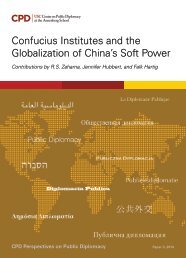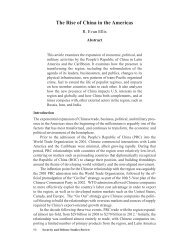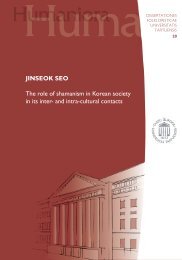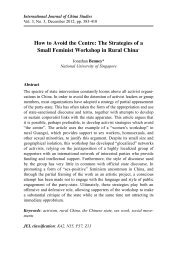JennyChan.PhDThesis.2014.FINAL
JennyChan.PhDThesis.2014.FINAL
JennyChan.PhDThesis.2014.FINAL
You also want an ePaper? Increase the reach of your titles
YUMPU automatically turns print PDFs into web optimized ePapers that Google loves.
past, when poor migrants were unable to present authorities valid legal papers. 21<br />
December 2007, according to one estimate, only 40 percent of China’s older labor<br />
force was still in agriculture. 22 For this cohort of rural youth, the future lay in the<br />
cities.<br />
By<br />
The children of post-Mao China have grown up with new hopes and dreams. As of<br />
2009, the majority (65 percent) of the 145 million migrant workers had completed<br />
nine years of formal education, and 13 percent had attained a high school diploma. 23<br />
Young rural residents increasingly express a desire to broaden their horizons and<br />
experience a modern life and cosmopolitan consumption in megacities such as<br />
Shenzhen, Shanghai and Beijing, as well as other fast developing cities in inland<br />
provinces. 24 Indeed, while they retain the rural registration associated with their<br />
home village, some have grown up in and around cities and have little knowledge of<br />
or familiarity with agriculture or rural life. The city is not only their home, the only<br />
home they have known; it is also where everything appears to be happening. The<br />
countryside seems alien and far away. 25<br />
Young rural migrants comprise the majority of the new Chinese industrial labor force,<br />
who are concentrated in private enterprises and international firms. In a 2007 survey<br />
conducted in Beijing and other major cities, 70 percent of the 4,637 rural migrant<br />
worker respondents working in manufacturing, services, and extractive and<br />
construction industries aspired to “receive technical training,” the key step toward<br />
fulfilling their dream of rising within the system. 26 The contrast is clear with those<br />
21 The abolition of the detention and repatriation system in 2003 came only after the torture to death<br />
of a male migrant college graduate, Sun Zhigang, by Guangzhou officials, which triggered a national<br />
protest against discrimination of rural migrants by local residents and officials alike.<br />
22 Barry Naughton, 2010, “China’s Distinctive System: Can It Be a Model for Others?”, Journal of<br />
Contemporary China 19(65), p. 458.<br />
23 National Bureau of Statistics of the People’s Republic of China, 2010, “2009 ian ongmingong<br />
Jiance Diaocha Baogao” (Monitoring and Investigation Report on the Rural Migrant Workers in 2009)<br />
2009 年 農 民 工 監 測 調 查 報 告告 .<br />
http://www.360doc.com/content/13/1016/14/7157405_321860376.shtml<br />
24 All-China Federation of Trade Unions, 2010, “Guanyu Xinshengdai ongmingoing Wenti de<br />
Yanjiu Baogao” (Research Report on the Problems of the New Generation of Rural Migrant Workers)<br />
關 於 新 生 代 農 民 工 問 題 的 研 究 報 告 .<br />
http://www.chinanews.com/gn/news/2010/06-21/2353233.shtml; All-China Federation of Trade<br />
Unions, 2011, “2010 ian Qianye Xinshengdai ongmingong Zhuangkuang Diaocha ji Duice Jianyi”<br />
(Survey and Some Proposals Regarding the Conditions of the New Generation of Rural Migrant<br />
Workers at Enterprises in 2010) 2010 年 企 業 新 生 代 農 民 工 狀 況 調 查 及 對 策 建 議 .<br />
http://acftu.people.com.cn/GB/67582/13966631.html<br />
25 Pun Ngai and Lu Huilin, 2010, “Unfinished Proletarianization: Self, Anger and Class Action of the<br />
Second Generation of Peasant-Workers in Reform China,” Modern China 36(5), pp. 493-519.<br />
26 China Youth and Children Studies Center, 2007, “Zhongguo Xinshengdai ongmingong Fazhan<br />
Zhuangkuang ji Daiji Duibi Yanjiu Baogao” (New-Generation Chinese Rural Migrant Workers<br />
Development Conditions and Inter-Generational Comparative Research Report) 中 國 新 生 代 農 民 工<br />
8






